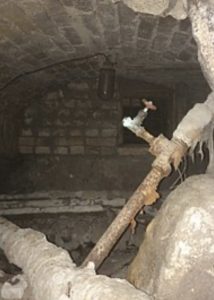World War II
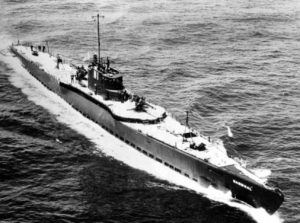
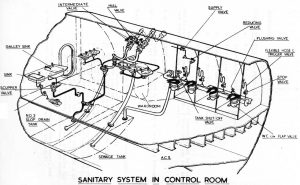 German submarine U-1206 was a Type VIIC U-boat of Nazi Germany’s Kriegsmarine during World War II. Construction started on June 12, 1943 at F. Schichau GmbH in Danzig. She was put into service on March 16, 1944 and a little over a year later, in April 14, 1945 she was at the bottom of the North Sea. The boat’s emblem was a white stork on a black shield with green beak and legs. U-1206 was one of the late-war boats that had been fitted with new deepwater high-pressure toilets, allowing their use while running at depth. These toilets were a rather complicated procedure, so special technicians were trained to operate them. Operating the toilets incorrectly…in the wrong sequence could result in waste or seawater flowing back into the hull. Not only would it have been a nasty mess, it could be dangerous.
German submarine U-1206 was a Type VIIC U-boat of Nazi Germany’s Kriegsmarine during World War II. Construction started on June 12, 1943 at F. Schichau GmbH in Danzig. She was put into service on March 16, 1944 and a little over a year later, in April 14, 1945 she was at the bottom of the North Sea. The boat’s emblem was a white stork on a black shield with green beak and legs. U-1206 was one of the late-war boats that had been fitted with new deepwater high-pressure toilets, allowing their use while running at depth. These toilets were a rather complicated procedure, so special technicians were trained to operate them. Operating the toilets incorrectly…in the wrong sequence could result in waste or seawater flowing back into the hull. Not only would it have been a nasty mess, it could be dangerous.
On April 14, 1945, just 24 days before the end of World War II in Europe, U-1206 was cruising at a depth of 200 feet, eight nautical miles off Peterhead, Scotland. A sailor decided that he knew the procedure for flushing the toilet, and after performing the procedure wrong, caused large amounts of seawater to flood the boat. According to the Commander’s official report, while in the engine room helping to repair one of the diesel engines, he was informed that a malfunction involving the toilet caused a leak in the forward section. The leak flooded the submarine’s batteries, which were located directly beneath toilet, causing them to generate chlorine gas. The Commander had no alternative but to surface. Immediately upon surfacing, basically right in the middle of several British patrol boats, U-1206 was torpedoed, forcing Schlitt to scuttle the submarine. One man died in the attack, three men drowned in the heavy seas after abandoning the vessel and 46 were captured.
I can’t imagine the frustration the Commander must have felt. Prior to the stupidity of one sailor, the submarine had been cruising along in relative safety. A forced surfacing was sure to put them in harms way, but the gas in 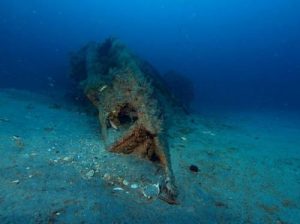
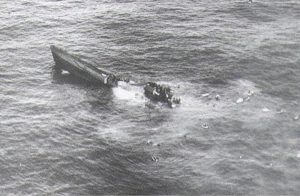 the submarine would most certainly kill them too. He did the only thing he could do, and U-1206 was at the bottom of the North Sea less than an hour later, where it would remain, hidden During survey work for the BP Forties Field oil pipeline to Cruden Bay in the mid 1970s, the remains of U-1206 were found at 57°21’N 01°39’W in approximately 230 feet of water.
the submarine would most certainly kill them too. He did the only thing he could do, and U-1206 was at the bottom of the North Sea less than an hour later, where it would remain, hidden During survey work for the BP Forties Field oil pipeline to Cruden Bay in the mid 1970s, the remains of U-1206 were found at 57°21’N 01°39’W in approximately 230 feet of water.
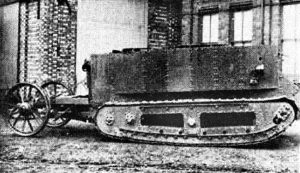 When I think of a tank, my thoughts go to an almost indestructible war machine, and I’m sure many people would agree with me. The tank was first introduced on September 6, 1915 in response to the trench warfare era of World War I. A British army colonel named Ernest Swinton and secretary of the Committee for Imperial Defense, William Hankey, championed the idea of an armored vehicle with “conveyor-belt-like tracks” over its wheels that could break through enemy lines and traverse difficult territory. It was a great idea, but the prototype tank nicknamed Little Willie manufactured in England was far from an overnight success. The tank was heavy, weighing in at 14 tons, but the big problem was that it got stuck in trenches and crawled over rough terrain at only two miles per hour. A tank isn’t much good if it has to be rescued, instead of rescuing the soldiers. It was also slow, and it became overheated and couldn’t cross the trenches. A second prototype, known as “Big Willie,” was produced. By 1916, this armored vehicle was deemed ready for battle and made its debut at the First Battle of the Somme near Courcelette, France, on September 15 of that year. Known as the Mark I, this first batch of tanks was hot, noisy and unwieldy and suffered mechanical malfunctions on the battlefield. Still, people began to realize the tank’s potential. Further design improvements were made and at the Battle of Cambrai in November 1917, 400 Mark IV’s proved much more successful than the Mark I, capturing 8,000 enemy troops and 100 guns.
When I think of a tank, my thoughts go to an almost indestructible war machine, and I’m sure many people would agree with me. The tank was first introduced on September 6, 1915 in response to the trench warfare era of World War I. A British army colonel named Ernest Swinton and secretary of the Committee for Imperial Defense, William Hankey, championed the idea of an armored vehicle with “conveyor-belt-like tracks” over its wheels that could break through enemy lines and traverse difficult territory. It was a great idea, but the prototype tank nicknamed Little Willie manufactured in England was far from an overnight success. The tank was heavy, weighing in at 14 tons, but the big problem was that it got stuck in trenches and crawled over rough terrain at only two miles per hour. A tank isn’t much good if it has to be rescued, instead of rescuing the soldiers. It was also slow, and it became overheated and couldn’t cross the trenches. A second prototype, known as “Big Willie,” was produced. By 1916, this armored vehicle was deemed ready for battle and made its debut at the First Battle of the Somme near Courcelette, France, on September 15 of that year. Known as the Mark I, this first batch of tanks was hot, noisy and unwieldy and suffered mechanical malfunctions on the battlefield. Still, people began to realize the tank’s potential. Further design improvements were made and at the Battle of Cambrai in November 1917, 400 Mark IV’s proved much more successful than the Mark I, capturing 8,000 enemy troops and 100 guns.
As with any new invention, the tank had a few “bugs” to be worked out. Still, I doubt if that did much to assuage the fears of the men in the tanks when they got stuck in the trenches. Tanks are supposed to be able to withstand gun shots and shrapnel, but would the tank be able to do so. After all, tanks weren’t supposed to get stuck either, so just how trustworthy was the armor plating. A tank that gets stuck is really just a “sitting duck.” Nevertheless, improvements were made to the original prototype and eventually tanks completely transformed military battlefields.
Trench warfare of World War I truly was brutal, almost more for the men in the trenches than anyone else.  Finally, the men appealed to British navy minister Winston Churchill, who believed in the concept of a “land boat” and organized a Landships Committee to begin developing a prototype. To keep the project secret from enemies, production workers were reportedly told the vehicles they were building would be used to carry water on the battlefield…alternate theories suggest the shells of the new vehicles resembled water tanks. Either way, the new vehicles were shipped in crates labeled “tank” and the name stuck. Tanks rapidly became an important military weapon. During World War II, they played a prominent role across numerous battlefields. The tanks potential was finally an accepted fact.
Finally, the men appealed to British navy minister Winston Churchill, who believed in the concept of a “land boat” and organized a Landships Committee to begin developing a prototype. To keep the project secret from enemies, production workers were reportedly told the vehicles they were building would be used to carry water on the battlefield…alternate theories suggest the shells of the new vehicles resembled water tanks. Either way, the new vehicles were shipped in crates labeled “tank” and the name stuck. Tanks rapidly became an important military weapon. During World War II, they played a prominent role across numerous battlefields. The tanks potential was finally an accepted fact.
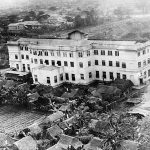
 When we think of Prisoners of War during the world wars, we usually think of the prisoners as being men, but there were women too…nurses. At that time, women couldn’t be in combat positions, and if they wanted to serve their country, it had to be as nurses or medics. One group of United States Army Nurse Corps and United States Navy Nurse Corps nurses, were stationed in the Philippines at the outset of the Pacific War, were later dubbed the Angels of Bataan (also including the the nurses of the island of Corregidor), were also called the Angels of Bataan and Corregidor and the Battling Belles of Bataan. The 78 nurses served during the Battle of the Philippines (1941–42). When Bataan and Corregidor fell, 11 Navy nurses, 66 army nurses, and 1 nurse-anesthetist were captured and imprisoned in and around Manila. These loyal, patriotic women continued to serve as a nursing unit while prisoners of war, taking care of their fellow prisoners, even if it meant punishment for their actions.
When we think of Prisoners of War during the world wars, we usually think of the prisoners as being men, but there were women too…nurses. At that time, women couldn’t be in combat positions, and if they wanted to serve their country, it had to be as nurses or medics. One group of United States Army Nurse Corps and United States Navy Nurse Corps nurses, were stationed in the Philippines at the outset of the Pacific War, were later dubbed the Angels of Bataan (also including the the nurses of the island of Corregidor), were also called the Angels of Bataan and Corregidor and the Battling Belles of Bataan. The 78 nurses served during the Battle of the Philippines (1941–42). When Bataan and Corregidor fell, 11 Navy nurses, 66 army nurses, and 1 nurse-anesthetist were captured and imprisoned in and around Manila. These loyal, patriotic women continued to serve as a nursing unit while prisoners of war, taking care of their fellow prisoners, even if it meant punishment for their actions.
After the attack on Pearl Harbor, the Japanese immediately went after the Philippines and the military personnel based there, including the nurses. In late December 1941, many of the nurses were assigned to a pair of battlefield hospitals on Bataan named Hospital #1 and Hospital #2. These hospitals included the first open-air wards since the Civil War. Tropical diseases, including malaria and dysentery, were widespread among both hospital patient and staff. Just prior to the fall of Bataan on April 9, 1942, the nurses serving there were ordered to the island fortress of Corregidor by General Wainwright (commander of the forces in the Philippines after MacArthur was ordered to Australia). Wainwright tried to save as many people as he could by moving them to the safer island of Corregidor. In the end it made no difference, because Corregidor was captured too.
During their occupation of the Philippines, the Japanese commandeered the campus of the University of Santo Tomas and converted it to be the Santo Tomas Internment Camp. In addition to its civilian population, Santo Tomas became the initial internment camp for both the army and navy nurses, with the army nurses remaining there until their liberation, while the soldiers were taken on the Bataan Death March. While there, the nurses continued to take care of anyone they were allowed to. Under the supervision of Captain Maude C Davison, a 57 year old nurse, with 20 years of service experience, the nurses continued to do their jobs. Davison took command of the nurses, maintained a regular schedule of nursing duty, and insisted that all nurses wear their khaki blouses and skirts while on duty.
The number of internees at Santo Tomas Internment Center in February 1942 amounted to approximately 4,670 people, of whom 3,200 Americans. Of those 3,200 Americans, 78 were nurses. The Americans, anticipating the war, had sent many wives and children of American men employed in the Philippines to the states before December 8, 1941. A few people had been sent to the Philippines from China to escape the war in that country. Some had arrived only days before the Japanese attack. The prisoners were crowded 30 to 50 people per small classrooms in university buildings. The allotment of space for each individual was 16 to 22 square feet. Bathrooms were scarce. Twelve hundred men living in the main building had 13 toilets and 12 showers. Lines were normal for toilets and meals. Internees with money were able to buy food and built huts, “shanties,” of bamboo and palm fronds in open ground where they could take refuge during the day, although the Japanese insisted that all internees sleep in their assigned rooms at night. Soon there were several hundred shanties and their owners constituted a “camp aristocracy.” The Japanese attempted to enforce a ban on sex, marriage, and displays of affection among the internees. They often complained to the Executive Committee about “inappropriate” relations between men and women in the shanties.
The conditions at Santo Tomas were horrific. The biggest problem for the internees was sanitation, followed closely by starvation. The Sanitation and Health Committee had more than 600 internee men working for it. Their tasks included building more toilets and showers, laundry, dishwashing, and cooking facilities, disposal of garbage, and controlling the flies, mosquitoes, and rats that infested the compound. Then, in January 1944, control of the Santo Tomas Internment Camp changed from Japanese civil authorities to the Imperial Japanese Army, with whom it remained until the camp was liberated. Food, which had been scarce before, was reduced to only 960 calories per person per day by November 1944, and then to 700 calories per person per day by 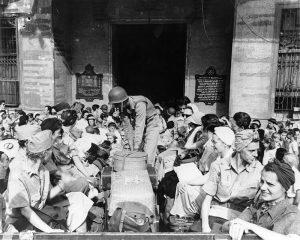 January 1945. At the time the nurses were finally released, it was found that they had lost, on average, 30% of their body weight during internment, and subsequently experienced a degree of service-connected disability “virtually the same as the male ex-POW’s of the Pacific Theater.” Davison’s body weight dropped from 156 pounds to 80 pounds.
January 1945. At the time the nurses were finally released, it was found that they had lost, on average, 30% of their body weight during internment, and subsequently experienced a degree of service-connected disability “virtually the same as the male ex-POW’s of the Pacific Theater.” Davison’s body weight dropped from 156 pounds to 80 pounds.
Finally, General Douglas MacArthur, emboldened by the success of the Raid at Cabanatuan, ordered Major General Vernon D Mudge to make an aggressive raid on Santo Tomas in the Battle of Manila in 1945. The internees at Santo Tomas, including the nurses, were liberated on February 3, 1945, by a “flying column” of the 1st Cavalry.
 When Hitler took power in Germany, the first goal was to take away the guns from the people. He then dismantled the police, and set up his own police force…loyal only to him. This was the beginning of Hitler’s planned takeover…first of Germany, and then the world. That was his goal, but thankfully, the world fought back, and evil did not prevail.
When Hitler took power in Germany, the first goal was to take away the guns from the people. He then dismantled the police, and set up his own police force…loyal only to him. This was the beginning of Hitler’s planned takeover…first of Germany, and then the world. That was his goal, but thankfully, the world fought back, and evil did not prevail.
World War II had gone on for almost five years…long years. Hitler’s forces were reeling from the devastating effects of D-Day, and Paris was next in line for liberation, The Allied machine was marching in to Paris to remove the Nazi Regime. Hitler was furious, and decided that if his army was to be forced out, they would take the best of the memories and landmarks of Paris with them. He planned to leave the city in smoldering ruins. Hitler issued the first of several orders to the German commander of Paris, General Dietrich von Choltitz, to destroy the city. What Hitler had not anticipated, was that von Choltitz would not blindly do his bidding. The last last commander of Nazi-occupied Paris in 1944, von Choltitz disobeyed Adolf Hitler’s orders to destroy the city, and instead surrendered it to Free French forces when they entered the city on August 25th. Choltitz later asserted that his defiance of Hitler’s direct order stemmed from its obvious military futility, his affection for the French capital’s history and culture, and his belief that Hitler had by then become insane, while other sources point to the fact that he had little control of the city thanks to the operations of the resistance, and could not have carried out such orders. Nevertheless, von Choltitz has since been referred to as “The Saviour of Paris.”
As I look at the current circumstances in the United States, I am reminded of the days of Hitler’s reign of terror. The riots in the streets, the calls for gun control and defunding the police, and the removal of the statues marking our past…good and bad, are all reminiscent of the days of early World War II. Just as in the days of 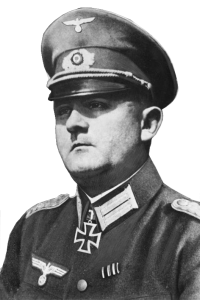 Hitler’s National Socialist Party, Socialism would not be good for America either. While the Democratic Party voters should understand that their values are like Hitler’s and yet, often blame the Republican party for being like Hitler, they are wrong. If they would look at history, instead of trying to remove our memory of the past, they would see just how alike Socialism is to Nazism and Hitler’s ways. Truly, the people of the United States need to wake up…and quickly. The decision to try to change our country to Socialism, is a slippery slope to communism, and the removal of the freedoms we hold so dear. We need to approach our future with our eyes wide open about the past of other nations, as well as the greatness that the American system of Capitalism has provided our nation with in the past. We like our freedom to let our voice be heard…a right that is found only in Capitalism. Don’t let the rights and privileges we so enjoy, be stolen from us by a handful of radical Socialists and Communists. The time to stand against Socialism and Communism is now!! Wake up America!!
Hitler’s National Socialist Party, Socialism would not be good for America either. While the Democratic Party voters should understand that their values are like Hitler’s and yet, often blame the Republican party for being like Hitler, they are wrong. If they would look at history, instead of trying to remove our memory of the past, they would see just how alike Socialism is to Nazism and Hitler’s ways. Truly, the people of the United States need to wake up…and quickly. The decision to try to change our country to Socialism, is a slippery slope to communism, and the removal of the freedoms we hold so dear. We need to approach our future with our eyes wide open about the past of other nations, as well as the greatness that the American system of Capitalism has provided our nation with in the past. We like our freedom to let our voice be heard…a right that is found only in Capitalism. Don’t let the rights and privileges we so enjoy, be stolen from us by a handful of radical Socialists and Communists. The time to stand against Socialism and Communism is now!! Wake up America!!

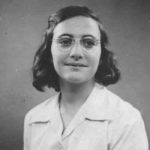 I recently listened to a book entitled, Treasures From The Attic, by Mirjam Pressler (in conjunction with Gerti Elias, wife of Buddy Elias, cousin of Anne Frank). I was not sure upon beginning the book, if it would hold any value concerning my interest in World War II and the Holocaust, but my concerns were quickly laid to rest as I listened to the story unfold. I’m not going to go into the story line really, except to say that the “treasures” that lay in the attic were partly about Anne Frank, but really more about the Frank family, and their torturous journey to learn the truth, and then to recover from it.
I recently listened to a book entitled, Treasures From The Attic, by Mirjam Pressler (in conjunction with Gerti Elias, wife of Buddy Elias, cousin of Anne Frank). I was not sure upon beginning the book, if it would hold any value concerning my interest in World War II and the Holocaust, but my concerns were quickly laid to rest as I listened to the story unfold. I’m not going to go into the story line really, except to say that the “treasures” that lay in the attic were partly about Anne Frank, but really more about the Frank family, and their torturous journey to learn the truth, and then to recover from it.
The many letters written to the various members of the family to other members of the family, told the tale of not just loss, but the tragic and horrific time of not knowing. It was the “not knowing” that most tore at my heart. First the fact that most of Otto Frank’s extended family had no idea that his little family; comprised of his wife, Edith and daughters Margot and Anne; had fallen into the hands of the evil Nazi Regime. As was the practice during the Holocaust, the family was separated, and Otto did not know of the fate of his wife and daughters at the time of his release from Auschwitz-Birkenau. Of course, we now know that Edith had passed away on January 6, 1945, of starvation. His daughter, Margot died sometime in February or March 1945 of Typhus, and his daughter, Anne also died in February or March 1945 of Typhus. The bodies of the girls were thrown behind a building and later into a mass grave as their burial. The Jews were considered no more important that trash, and so were treated as such. While this is horrific enough, worse was the fact that all too often no record was kept of the dead, or their place of burial.
It was here that I began to feel the horrible longing, dread, and finally grief that the Frank family was going through. As anyone who has lost a loved on and doesn’t know what happened can tell you, the not knowing is almost worse than the reality of what happened. Your mind can conjure up so many things, and for Otto, who had also been in the camp can readily attest, the reality of Auschwitz-Birkenau was beyond all human comprehension, unless you had been there, and then you could not get it out of your head. Still, the months of 
 waiting for news of his family, followed by years of grief and heartache over what they had suffered, was beyond anything that most people can fathom. As I finished the book, I felt a tremendous sense of loss, not only for the Frank family, but for the many Jewish families, who suffered in the camps, and after the Holocaust as they endeavored to locate lost loved ones, or at least to learn their fate. Many searched for years, and some have never found out the fate of their loved ones at all. It was truly heartbreaking, and yet, that search and not knowing, was the reality that was faced by many Holocaust survivors.
waiting for news of his family, followed by years of grief and heartache over what they had suffered, was beyond anything that most people can fathom. As I finished the book, I felt a tremendous sense of loss, not only for the Frank family, but for the many Jewish families, who suffered in the camps, and after the Holocaust as they endeavored to locate lost loved ones, or at least to learn their fate. Many searched for years, and some have never found out the fate of their loved ones at all. It was truly heartbreaking, and yet, that search and not knowing, was the reality that was faced by many Holocaust survivors.
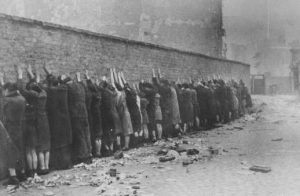 When the Nazis began their annihilation of of the Jewish people, many were caught completely unaware. I think it’s impossible to think that anyone could do such horrible things to other human beings. Many of the Jews actually went along with how things were going…at first. By the time they realized the predicament they were in, it was too late. Other Jews, somehow knew that moving into the “ghetto” was the beginning of their end. Some thought they would never leave their homeland, but would rather wait out the war, which would “be over before they knew it,” but it wasn’t over…not for a long time, and for some ended only in death. Many Jewish families wouldn’t survive the war, at least not intact. Over the years of the war, no Jews could say they didn’t know anyone who had died, because they all knew some who had died, and often it was their own family members.
When the Nazis began their annihilation of of the Jewish people, many were caught completely unaware. I think it’s impossible to think that anyone could do such horrible things to other human beings. Many of the Jews actually went along with how things were going…at first. By the time they realized the predicament they were in, it was too late. Other Jews, somehow knew that moving into the “ghetto” was the beginning of their end. Some thought they would never leave their homeland, but would rather wait out the war, which would “be over before they knew it,” but it wasn’t over…not for a long time, and for some ended only in death. Many Jewish families wouldn’t survive the war, at least not intact. Over the years of the war, no Jews could say they didn’t know anyone who had died, because they all knew some who had died, and often it was their own family members.
One such family, the Shwartz family managed over the years of the war to escape time after time to emerge intact…against all odds. The family had been hit by loss, of course, but not at the hands of the Nazis. At first their lives weren’t affected. They lived in the country, and the “ghettos” seemed so far away. Then it started. It began with the Russians, yes Russians…they had been there at first in an effort to hold back the Germans, but in this case, they weren’t much better than the Germans. At first they took the vegetables and livestock to feed the soldiers, then they took the home. So the family moved.
When the Germans invaded, the family moved to a different town, but before long they were expected to go to the “ghettos.” Instead, they made their escape from Poland to Romania. Before long the family had to be split up to protect themselves. They lived in barns and small sheds, but still they weren’t really safe. They finally had to put their children up for adoption to Christian families, but even that wasn’t safe later on, and the children ended up back with their own parents. Eventually, one of the children at all of ten years old, decided that he was going to Palestine. He went, but they thought he had died when the ship sank. In reality, he was on a different ship, because his ship had been overbooked.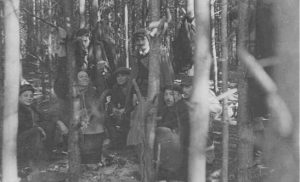
His aunt had also been with the family, and she had been able to move around under the radar, because of her blonde hair and blue eyes. She didn’t look Jewish. During one border crossing, the family was caught by German Gestapo, but the men were young and they were able to fool them into thinking they belonged. Of course, I am oversimplifying their entire ordeal, but miraculously, they entire family live through the Holocaust, without ending up in the camps, and in the end, they moved to Palestine, where they still live today.
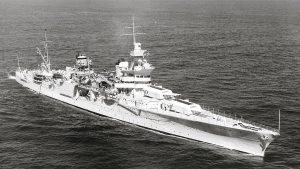 The USS Indianapolis (CL/CA-35) was a Portland-class heavy cruiser of the United States Navy, named for the city of Indianapolis, Indiana. The ship was launched in 1931, the vessel served as the flagship for the commander of Scouting Force 1 for eight years, then as flagship for Admiral Raymond Spruance in 1943 and 1944 while he commanded the Fifth Fleet in battles across the Central Pacific during World War II. Those were tumultuous times, and sometimes things “fell through the cracks,” but what happened to the USS Indianapolis was seriously unthinkable.
The USS Indianapolis (CL/CA-35) was a Portland-class heavy cruiser of the United States Navy, named for the city of Indianapolis, Indiana. The ship was launched in 1931, the vessel served as the flagship for the commander of Scouting Force 1 for eight years, then as flagship for Admiral Raymond Spruance in 1943 and 1944 while he commanded the Fifth Fleet in battles across the Central Pacific during World War II. Those were tumultuous times, and sometimes things “fell through the cracks,” but what happened to the USS Indianapolis was seriously unthinkable.
In July 1945, after the Indianapolis completed a top-secret high-speed trip to deliver parts of Little Boy, the first nuclear weapon ever used in combat, to the United States Army Air Force Base on the island of Tinian, they subsequently departed for Guam and then it was on to the Philippines on training duty. Little Boy was the bomb that was going to effectively end the war, but the war was not over yet, and it was imperative that everyone be on high alert. The waters in many areas of the world were filled with hidden dangers…namely, German U-Boats and Imperial Japanese Navy Submarines. Many a ship was sunk by these hidden enemies.
At 12:05am on July 30, 1945, the USS Indianapolis was torpedoed by the Imperial Japanese Navy submarine I-58, while en route to the Philippines. The mighty ship sank in just 12 minutes. There were 1,195 crewmen aboard, and approximately 300 went down with the ship, unable to get to the deck in time. The remaining 890 men were faced with exposure, dehydration, saltwater poisoning, and shark attacks while stranded in the open ocean with few lifeboats and almost no food or water. The scene was horrible. The men in the water could not necessarily see the sharks, but the screams of their fellow crewmen were unmistakable. And if the crew wasn’t dying by shark attack, they were slowly dying at the hands of the elements. Dehydration caused many to drink the saltwater that was in abundance around them, but soon it poisoned them, and instead of saving them, it killed them.
Because of the speed with which USS Indianapolis sank, there was no time to send a distress signal or even  deploy all of the lifeboats and equipment. The men knew they would need to survive until their ship was overdue and reported missing. They didn’t know how long it would take, and this is where the Navy failed these men. Navy directive 10CL45, which meant no reporting of combatant ships that failed to arrive. No search until by accident someone saw an oil slick. When Indianapolis was overdue, the people who would have reported it as overdue, simply assumed that Indianapolis might have been redeployed to another training area, since that was part of their mission. According to the directive, no search crews were sent out. These men were unthinkably alone in the vast sea…and no help was coming. In fact, the Navy only learned of the sinking four days later, when survivors were spotted by the crew of a PV-1 Ventura on routine patrol. By the time the rescue began, only 316 of the 890 men who survived the original sinking were still alive. The sinking of Indianapolis and Navy directive 10CL45 resulted in the greatest single loss of life at sea from a single ship in the history of the US Navy.
deploy all of the lifeboats and equipment. The men knew they would need to survive until their ship was overdue and reported missing. They didn’t know how long it would take, and this is where the Navy failed these men. Navy directive 10CL45, which meant no reporting of combatant ships that failed to arrive. No search until by accident someone saw an oil slick. When Indianapolis was overdue, the people who would have reported it as overdue, simply assumed that Indianapolis might have been redeployed to another training area, since that was part of their mission. According to the directive, no search crews were sent out. These men were unthinkably alone in the vast sea…and no help was coming. In fact, the Navy only learned of the sinking four days later, when survivors were spotted by the crew of a PV-1 Ventura on routine patrol. By the time the rescue began, only 316 of the 890 men who survived the original sinking were still alive. The sinking of Indianapolis and Navy directive 10CL45 resulted in the greatest single loss of life at sea from a single ship in the history of the US Navy.
 Built in Seattle, Washington by Boeing, the B-17G, which was later converted to a B-17H for use as an emergency air-sea rescue plane. It was equipped with a Higgins A-1 lifeboat attached to the lower fuselage. The plane and crew including Pilot, 1st Lieutenant William C Motsinger; Co-Pilot, 2nd Lieutenant Robert W Ball; Crew, 1st Lieutenant Rollin C Marsh; Engineer, Captain Norman E Zahrt; Navigator, Technical Sergeant Robert W Conger; Gunner, Staff Sergeant Gerard J Doody; Crew, Staff Sergeant Charles J Parkins; Crew, Sergeant Charles Edward Hurn; Crew, Sergeant Elliott Leroy Griffin; and Crew, Sergeant Otis E Anderson Jr; was assigned to the 20th Air Force, 4th Emergency Rescue Squadron. The plane was given no known name or nose art, which happened more than people knew, but it had a Radio Call Sign of “Jukebox 21.”
Built in Seattle, Washington by Boeing, the B-17G, which was later converted to a B-17H for use as an emergency air-sea rescue plane. It was equipped with a Higgins A-1 lifeboat attached to the lower fuselage. The plane and crew including Pilot, 1st Lieutenant William C Motsinger; Co-Pilot, 2nd Lieutenant Robert W Ball; Crew, 1st Lieutenant Rollin C Marsh; Engineer, Captain Norman E Zahrt; Navigator, Technical Sergeant Robert W Conger; Gunner, Staff Sergeant Gerard J Doody; Crew, Staff Sergeant Charles J Parkins; Crew, Sergeant Charles Edward Hurn; Crew, Sergeant Elliott Leroy Griffin; and Crew, Sergeant Otis E Anderson Jr; was assigned to the 20th Air Force, 4th Emergency Rescue Squadron. The plane was given no known name or nose art, which happened more than people knew, but it had a Radio Call Sign of “Jukebox 21.”
B-17H Flying Fortress Serial Number 43-38882, aka Jukebox 21, took off from Motoyama Number 1 Airfield on Iwo Jima, on July 25, 1945, on a night search mission for F4U Corsair 81319 that crashed the day before near Arai at roughly over Lat 34° 35′ N, Long 137° 35′ E on the southern coast of Honshu, Japan. The weather was good, and yet Jukebox 21 was lost, without making a distress signal. That fact made the circumstances of the crash hard to figure, and only known when the B-17 failed to return. The crew was officially listed as Missing In Action, and later as killed in action.
The B-17 flew over Maisaka near the Benten Jima bridge, flying northward at an altitude of roughly 984 feet. Crossing the coast, 75mm anti-aircraft guns on the south side of the highway at Benten Jima opened fire on the bomber. Jukebox 21 was hit by anti-aircraft fire, one of the engines began smoking as the plane flew northward, then attempted to circle to the west over Lake Hamana, then southward. Trailing black smoke, one of the engines on the right wing broke off before the bomber crashed at Yakute to the northwest of Arai. Jukebox 21 impacted pine trees before crashing into the ground nose first at Yakute, to the northwest of Arai. Immediately after the crash, Japanese civilians ran to the crash site and observed several mounds of debris and fire and observed the rescue boat in the wreckage. There were no survivors. Thirty minutes after the crash, Japanese Keibodan (wartime guards) reached the crash site and extinguished the fire. The bodies of the ten crew were recovered, all badly burned from the fire and no identification was possible. Afterwards, the bodies of the crew were cremated and buried at the nearby Arai crematorium, along with the body of the Corsair pilot that crashed the previous day.

Twelve Allied aircraft participated in a search over two days under the direction of Major Ivan K Mays. No wreckage was located, and all stations and ships were told to be on the lookout for this bomber. On May 22, 1947 US Army investigators visited Arai to investigate the possibilities of any atrocities in connection with the death of this crew, but found none. During their visit, they interrogated Katsumi Kumagai the former Kempei Tai commander for Arai who explained how the B-17 crashed and how the crew’s bodies were recovered, cremated, and buried. Afterwards, the remains of the crew were recovered and transported to the United States for permanent burial. Somewhat strangely, the Japanese placed a memorial to the men of Jukebox 21 at the Jingu-ji Temple in Kosai, Japan.
 Most of us know Julia Child as a famous chef, who mainly focused on French cuisine, as well as an author of cookbooks, but that is only one aspect of her life. Born Julia Carolyn McWilliams in Pasadena, California on August 15, 1912, she was the daughter of John McWilliams Jr, and Julia Carolyn “Caro” (Weston) McWilliams. She came from wealth as privilege, her dad being a Princeton Graduate and prominent land manager, and her mom being a paper-company heiress. She was the eldest of three children, followed by John McWilliams III and Dorothy (McWilliams) Cousins. Child and her siblings were all unusually tall, and loved outdoor sports. After she graduated, Julia went on to major in history in college, after college took a job as a copywriter for a furniture company in New York City.
Most of us know Julia Child as a famous chef, who mainly focused on French cuisine, as well as an author of cookbooks, but that is only one aspect of her life. Born Julia Carolyn McWilliams in Pasadena, California on August 15, 1912, she was the daughter of John McWilliams Jr, and Julia Carolyn “Caro” (Weston) McWilliams. She came from wealth as privilege, her dad being a Princeton Graduate and prominent land manager, and her mom being a paper-company heiress. She was the eldest of three children, followed by John McWilliams III and Dorothy (McWilliams) Cousins. Child and her siblings were all unusually tall, and loved outdoor sports. After she graduated, Julia went on to major in history in college, after college took a job as a copywriter for a furniture company in New York City.
With the onset of World War II, Julia tried to enlist in military service, but was told that she was too tall to enlist in the Women’s Army Corps (WACs) or in the U.S. Navy’s WAVES…both facts that make no sense to me, and probably would not have been a factor these days. Nevertheless, Julia was declined that chance to serve.  Undeterred, she joined the Office of Strategic Services (OSS) as a typist at its headquarters in Washington but, because of her education and experience, soon was given a more responsible position as a top-secret researcher working directly for the head of OSS, General William J. Donovan. Thus began a career that would lead to being a spy for the Allied forces and have a life changing effect on Julia’s life.
Undeterred, she joined the Office of Strategic Services (OSS) as a typist at its headquarters in Washington but, because of her education and experience, soon was given a more responsible position as a top-secret researcher working directly for the head of OSS, General William J. Donovan. Thus began a career that would lead to being a spy for the Allied forces and have a life changing effect on Julia’s life.
In 1944, she was posted to Kandy, Ceylon (now Sri Lanka). Her responsibilities included “registering, cataloging and channeling a great volume of highly classified communications” for the OSS’s clandestine stations in Asia. Later she was transferred to Kunming, China, where she received the Emblem of Meritorious Civilian Service as head of the Registry of the OSS Secretariat. Asked to solve the problem of too many OSS underwater explosives being set off by curious sharks, “Child’s solution was to experiment with cooking various concoctions as a shark repellent,” a task she did in a bathtub…not much like her cooking in later years. The chemicals were sprinkled in the water near the explosives and repelled sharks…it was a great success and is still in use today. The experimental shark repellent “marked Child’s first foray into the  world of cooking” Child received an award that cited her many virtues, including her “drive and inherent cheerfulness.”
world of cooking” Child received an award that cited her many virtues, including her “drive and inherent cheerfulness.”
While in Kunming, she met Paul Cushing Child, also an OSS employee, and the two were married September 1, 1946, in Lumberville, Pennsylvania. They later relocated to Washington DC. Paul was a New Jersey native who had lived in Paris as an artist and poet. He was also known for his sophisticated palate, and introduced his wife to fine cuisine. Julia had always had a cook in her childhood home, so the idea of cooking was very foreign to her. Still, she was smart, and she began to excel in the art of cooking. It was her cooking that helped her to realize another of her goals…to become an author. Cooking was not a goal is a girl, but it was her later love of cooking that finally gave her the title of writer she had so desired. While Julia and Paul never had children, they lived a long and happy life until his passing in 1994. Then she went on until her own passing in 2004 at the good old age of 91.

